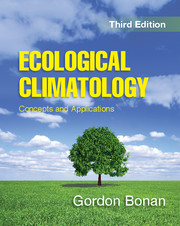Book contents
- Frontmatter
- Dedication
- Contents
- Preface
- 1 Ecosystems and Climate
- Part I The Earth System
- Part II Global Physical Climatology
- 4 Atmospheric Radiation
- 5 Atmospheric General Circulation and Climate
- 6 Earth's Climates
- 7 Climate Variability
- 8 Climate Change
- Part III Hydrometeorology
- Part IV Biometeorology
- Part V Terrestrial Plant Ecology
- Part VI Terrestrial Forcings and Feedbacks
- Appendix
- Index
- Plate section
- References
7 - Climate Variability
from Part II - Global Physical Climatology
Published online by Cambridge University Press: 05 November 2015
- Frontmatter
- Dedication
- Contents
- Preface
- 1 Ecosystems and Climate
- Part I The Earth System
- Part II Global Physical Climatology
- 4 Atmospheric Radiation
- 5 Atmospheric General Circulation and Climate
- 6 Earth's Climates
- 7 Climate Variability
- 8 Climate Change
- Part III Hydrometeorology
- Part IV Biometeorology
- Part V Terrestrial Plant Ecology
- Part VI Terrestrial Forcings and Feedbacks
- Appendix
- Index
- Plate section
- References
Summary
Chapter Summary
The previous chapters focused on the mean state of the atmosphere and climate zones. However, the realized temperature and precipitation in any year can deviate markedly from the long-term climatology. Some years are warmer or colder than normal; some are wetter or drier than normal. This is a realization of climate variability at seasonal-to-interannual timescales. Major modes of climate variability include the El Niño/Southern Oscillation and the North Atlantic Oscillation. El Niño is a large-scale warming of sea surface temperature in the eastern tropical Pacific. It is associated with a reduced Walker circulation that weakens the trade winds, with below-normal rainfall in the western tropical Pacific and above-normal rainfall along the equator east of the dateline. The changes in tropical sea surface temperature and atmospheric circulation affect temperature and precipitation worldwide. The North Atlantic Oscillation is associated with changes in the strength of the Icelandic low and subtropical high in the North Atlantic during winter. This affects the strength of middle latitude westerlies, with consequences for winter temperature and precipitation from eastern North America to Europe and Asia.
Floods, Droughts, and Heat Waves
Climate is often described in terms of climatic means, typically defined by 30-year averages. For example, the mean temperature for the month of July in central England during the period 1971–2000 was 16.5°C (Figure 7.1a). However, the monthly temperature varied considerably from this 30-year mean in any given year. The minimum monthly temperature during the 30-year period was 14.7°C; the maximum was 19.5°C. The average temperature was realized in only two years. The July temperature was below average in 16 years and above average in 12 years. Temperature in five years was one or more standard deviations (1.3°C) below average and more than one standard deviation above average in another five years. An extended temperature record for central England over a 347-year period further illustrates the nature of climate variability (Figure 7.1b). Between 1659 and 2005, July temperature averaged 16.0°C but ranged from a high of 19.5°C to a low of 13.4°C. As seen in the 30-year running mean temperature, there have been distinct periods of warming and cooling in central England.
- Type
- Chapter
- Information
- Ecological ClimatologyConcepts and Applications, pp. 103 - 116Publisher: Cambridge University PressPrint publication year: 2015



